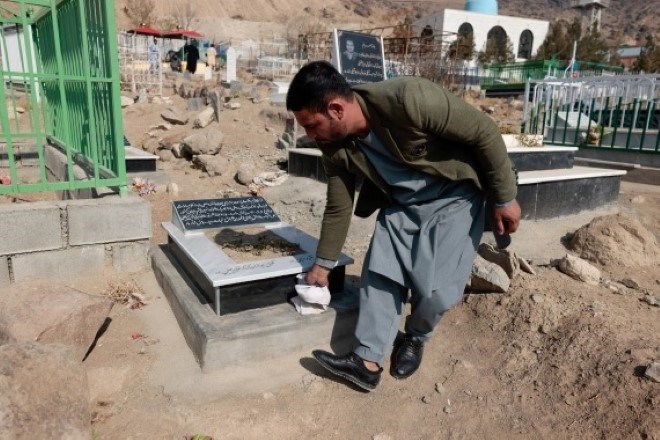
Thursday September 29, 2022
Monitors have regularly questioned the Pentagon’s annual tally, which is perenially far below independent counts.
Emal Ahmadi cleans the grave of his daughter Malika, who was a victim of a US drone attack that killed 10 civilians, including seven children in Kabul, Afghanistan in August 2021 [File: Zohra Bensemra/Reuters]
The United States Department of Defense, which has for years been accused of vastly under-investigating and under-reporting civilian casualties, has released a congressionally mandated annual report on civilians killed by the US military worldwide in 2021, listing just 12 civilian killings it determined to be “credible”.
The report late on Tuesday renewed perennial scepticism about official US military counts of civilian casualties.
“Once again the confirmed civilian casualty count is below what communities on the ground are reporting,” Emily Tripp, the director of the Airwars conflict monitor, told Al Jazeera on Wednesday. She added that “dozens of unique incidents” involving potential civilian casualties identified by the group in Syria in 2021 “appear unaccounted for in the report”.
The Pentagon’s release said all of the civilian killings in 2012 took place in Afghanistan. A previously acknowledged US drone attack that killed 10 family members, including seven children, in Kabul on August 29, 2021, accounted for the majority of civilian deaths confirmed by the Pentagon for the whole of the year. US officials have publicly called the attack a “mistake”, but said no personnel would be punished for the incident.
The count in the annual report, which is mandated under the 2018 National Defense Authorization Act, represented a decline from 2020, when the Pentagon admitted to killing 23 civilians and wounding 10 in attacks in Afghanistan, Somalia and Iraq. That number was itself a steep drop from the three previous years of reporting in the wake of the passage of the 2018 law, which created higher standards for the Department of Defense’s notoriously ad hoc and opaque reporting process.
In its initial report in 2017, the Pentagon confirmed 499 civilians killed by US forces. In 2018, it confirmed 120 civilians were killed and in 2019, it confirmed 132 killings. Subsequent reports have added to the official tally for past years, with last year’s report adding 32 civilian deaths to the 2017 to 2019 period. Tuesday’s report also added 10 more civilian deaths to the period between 2018 and 2020.
Independent monitors have said the downward trend broadly reflects a dramatic decline in US air raids worldwide as Washington has sought to phase out its so-called “war on terror” launched in the wake of the September 11, 2001, attacks, which has included the US withdrawal from Afghanistan and the end of the US combat mission in Iraq.
Still, rights groups have regularly accused the Pentagon of severely undercounting civilian casualties, with independent counts often many times higher.
Writing for Just Security in 2021, Annie Shiel of the Center for Civilians in Conflict (CIVIC) and Airwars co-founder Chris Woods decried that year’s report from the Pentagon as continuing the “legacy of unrecognised harm” amid the “significant undercounting of civilian casualties”, while noting that conservative tallies of civilian killed by US forces in 2020 were almost five times the count of the 23 civilian killings acknowledged by the department that year.
An Airwars analysis on civilian casualties in 2021 noted “US-led Coalition actions” in Syria alone were estimated to have killed between 15 and 27 civilians.
In the latest report, the Pentagon said it had received six reports of potential civilian casualty incidents in Iraq and Syria in 2021, which came from military units, social media, news reports and conflict monitors. It said three of those reports were deemed to be not credible, while three remained under assessment.
The department also said it had received a total of 10 reports of potential civilian casualty incidents in Afghanistan in 2021, six of which were deemed not credible.
The Department of Defense maintains it reviews all reports of civilian casualties, regardless of their source.
The Pentagon report added that the 2021 tally only accounted for casualties reported in “a declared theatre of active armed conflict”, which it said included Afghanistan, Iraq, Syria and Somalia in 2021.
In 2019, former US President Donald Trump revoked an executive order by his predecessor, Barack Obama, which required the head of the US intelligence to report civilian deaths from controversial US drone attacks conducted outside of warzones, usually by the Central Intelligence Agency (CIA) which is not part of the Department of Defense.
Tuesday’s release comes just weeks after US Secretary of Defense Lloyd Austin launched an action plan aimed at mitigating civilian harm in military operations while standardising how the military assesses and investigates civilian casualties – processes previously left up to individual branches of the armed forces.
He called the protection of civilians “a strategic priority as well as a moral imperative”.
The plan came in the wake of a December 2021 New York Times newspaper report that detailed 10 years of US air wars in the Middle East wrought with “deeply flawed intelligence” and “faulty targeting” that reportedly killed more than 1,300 civilians. Repeated pledges of transparency and accountability, the investigation found, had regularly fallen short.
The new plan has been broadly welcomed by rights monitors but has been criticised for not containing clear measures for accountability. It is meant to be fully implemented by 2025.